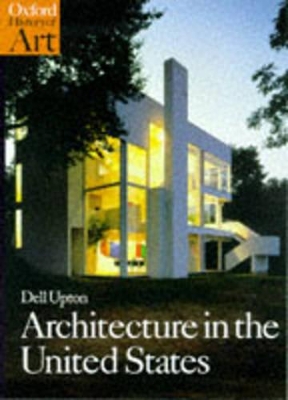American Architecture is astonishingly varied. From Indian sites in New Mexico and Arizona, and the ancient earthworks of the Mississippi Valley, to the most fashionable contemporary buildings of Chicago and New York, the United States boasts three thousand years of architectural history. It is characterized by the diversity of its builders and consumers who include Native American men and women, African, Asian, and European immigrants, as well as renowned
professional architects and urban planners.
Dell Upton's revolutionizing interpretation examines American architecture in relation to five themes: community, nature, technology, money, and art. In giving particular attention to indigenous, folk, ethnic and popular architectures like Chaco Canyon, Brooklyn suspension bridge, and native American houses, as well as to the great monuments of traditional histories such as Jefferson's Monticello and Wright's Fallingwater, Architecture in the United States reveals the dazzling richness
of America's human landscape.
From the pre-publication reviews:
Dell Upton: Architecture in the United States - Reviews 'In Architecture in the United States Dell Upton essentially reinvents American architectural history. Employing a series of cultural, economic, and political contexts, his incisive and entertaining narrative examines some 3,000 years of human intervention in the natural landscape, contrasting, comparing and interweaving an astounding range of built forms. This ingenious approach focuses our attention on both the commonality and
diversity of human experiences that have shaped this country. Upton's book should be read by everyone with an interest in America's cultural landscape. They will never look at it in the same way again.'
Professor Kenneth A. Breisch Southern California Institute of Architecture
'In Architecture in the United States Dell Upton has dismantled the typical chronological history of American architecture and reconceived it as a thematic history, organized according to the compelling themes of "Community", "Nature", "Technology", "Money", and "Art". Upton's very broad definitions of architecture includes traditional high-art monuments like Thomas Jefferson's Monticello or Frank Lloyd Wright's Falling Water, alongside Native American houses and earthworks, typical courthouse
squares, recent planned suburbs, bridges, world's fair pavilions, office buildings, and other categories of building that gives the book its freshness and forces readers to reconsider received ideas about American architecture. The book begins with a tour-de-force chapter on Monticello in which all
the themes are brought to bear in explaining the meanings embodied in this one site. Upton's inclusive analysis delivers sharp insights about buildings that are so familiar one would have thought there was nothing more to be said. His method invites us to move beyond the limits of aesthetics, and to take more risks to ask more wide-ranging questions about the architecture we inhabit and study.'
Professor Elizabeth Cromley Northeastern University
'Dell Upton has written an extraordinarily illuminating book that is a pleasure to read. It synthesizes the existing literature on American architecture while critically exploring fundamental questions about the nature and meaning of architectural, urban, and landscape design. There is a refreshing inclusiveness here about the meaning of both America and its architecture. The book's thematic structure reveals rich new possibilities for understanding American society and culture by
scrutinizing its architecture. By-passing conventional chronologies Upton represents cutting-edge historiographical methods but without the cant and jargon of contemporary theory. This important book will usefully transform our historical understanding of American architecture.'
Professor Daniel Bluestone University of Virginia
'The originality of Upton's conceptual framework makes everything he considers new, profound, and convincing. We see public and private space, social and individual effort, in a shifting dialectic resolvable into no stable patter. This Is architecture in motion. And at last we understand malls.'
Professor Garry Wills Northwestern University
'The organization of the material that the author chose is very intriguing and successfully communicates his ideas'
Rebecca L. Binder, FAIA Architect
- ISBN10 019284217X
- ISBN13 9780192842176
- Publish Date 30 April 1998
- Publish Status Active
- Publish Country GB
- Imprint Oxford University Press
- Format Paperback
- Pages 336
- Language English
